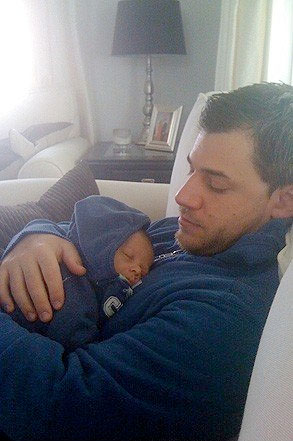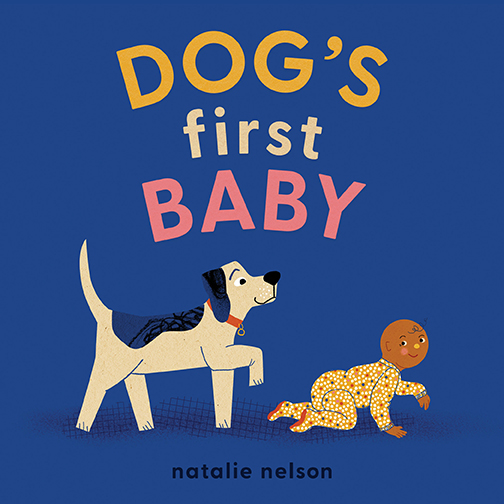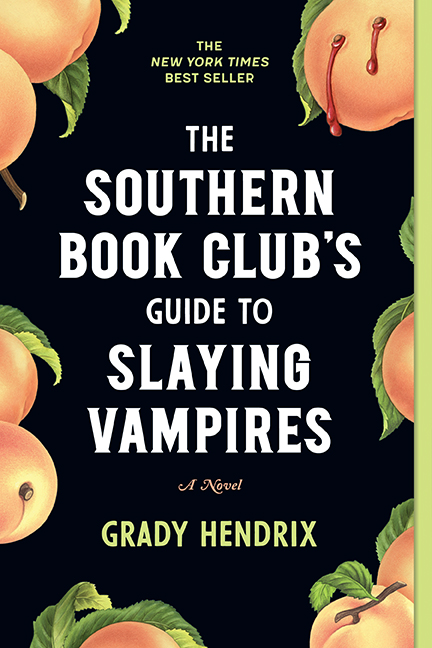Our Blog
Handling the New Baby
Local author Chris Illuminati and son
Some parents have the knowledge and the instincts down before their first child even arrives in the world. Others (like me if I ever have a child) will need a complete and detailed instruction book.
Let’s cover some basics today, from The Baby Owner’s Manual.
Handling the New Baby: Always wash your hands before handling the baby. Human skin contains bacteria that, when transferred to the baby, can cause him to function improperly. If you do not have access to soap and water, disinfect your hands with a baby wipe.
Picking Up the Baby
– Slide one hand under the baby’s neck and head to support them. In the first weeks, the baby’s neck has minimal function. Until it strengthens, handle the baby with care to prevent undesirable “flopping” of the head.
– Slide your other hand under his bottom and spine.
– Lift the baby close to your body.
Caution: When laying the baby down, always support the baby’s head with your hands, and ensure that the surface you put him on will support his head and neck.
Passing the Baby: During the baby’s first two months of life, the immune system is extremely fragile. It is recommended that you limit the number of visitors during this period. Before passing the baby to another person, be sure this person has washed his or her hands.
When one user wishes to pass the baby off to another, or when friends and family come to visit, use the following techniques to keep the baby safe.
– Use one hand to support the baby’s head and neck. Your other hand should support the baby’s bottom and spine.
– Have the other person cross his or her arms.
– Set the baby’s head and neck in the crook of one arm. Instruct the other person to support the baby’s head.
– Place the baby’s body into the crossed arms.
—
Posted by Courtney Daniels
Melancholia + Saying All of the Things You’ve Wanted to Say
It’s a shame that last year’s Melancholia will be better-remembered for director Lars von Trier’s Nazism jokes (tastelessly expressed at, of all places, the Cannes Film Festival) than its brave, unconventional response to the apocalypse.
Although judging from these squirm-inducing GIFs of Kirsten Dunst, seated next to von Trier while he was making said un-PC comments, you’d think the world was ending too:
http://fourfour.typepad.com/fourfour/2011/05/dunsts-finest-role.html
But Melancholia is the finest, most interesting apocalyptic film to date. The movie is divided into two acts: the first is Dunst’s wedding reception, where she acts bewilderingly ungrateful and fatalistic; in the entirely different second act, a distant planet (Melancholia) is headed on a collision course with Earth.
Charlotte Gainsbourg plays Dunst’s level-headed sister, and faced with the crippling mortality of everything, suddenly Dunst’s aloof cynicism seems more rational than Gainsbourg’s dissolving pragmatism. And if the world is ending, I can’t think of a better time to embrace one’s inner-jerk.
Whereas Hank, the detective in The Last Policeman, continues his investigations despite the fact that an asteroid is set to collide with Earth, I’d surrender all pretenses of being a friendly, productive human being. Because when I’m really honest with myself, I have no interest in being a nice person.
You see, at the end of the world, there’s no legacy — no one to remember how rotten you were in your final days, no last judgment. There’s just the pure satisfaction of saying all of the things you’ve wanted to say.
A few things I would say:
+ My friend Chad: “I’ve always been embarrassed to have a friend named Chad.”
+ Steelers fans: “You are all the worst people on Earth. Also don’t please hurt me.”
+ President Obama: “I agree with all your policies, but even if I didn’t, I’d probably still vote for you because you’re so handsome.”
+ All of my exes: “I’m still in love with you.”
I would also punch anyone who was listening to R.E.M.’s “It’s the End of the World.”
Truthfully though, I would probably never say any of these things, even if the world was ending. Instead, I’d probably just sit in my apartment and watch Melancholia a few more times. That movie is so good!
Kevin Nguyen is a writer / editor living from Seattle. Follow him on Twitter via @knguyen, and check out his website www.bygonebureau.com.
Posted by Kevin Nguyen
National Ice Cream Month: Berries & Buttermilk Smoothie Ice Cream Pops
Okay, so these aren’t quite ice cream, but they’re packed with fruit and simple, delicious ingredients like yogurt and honey.
Break the mold with these creamy treats worthy of National Ice Cream Month.
Berries and Buttermilk Smoothie Ice Cream Pops
From On A Stick by Matt Armendariz
Sweet, simple, and with a tang of buttermilk, these smooth ice cream pops are fun to make. Feel free to use any variety of frozen fruit that you have on hand.
Posted by Caroline Mills
Celebrate Chocolate Day on Etsy With Willy Wonka Inspired Crafts
What better way to celebrate July 7th, Chocolate Day than a look at some of the sweet confections the Etsy marketplace has to offer?
Though chocolate itself is available in abundance on the site, we thought we’d shine a spotlight on the creations inspired by the number one Candy Man himself: Mr. Willy Wonka.
Posted by Megan Christopher
Worst-Case Wednesday: Avoid a Grillmergency
Happy Independence Day!
Along with parades and fireworks, grilling up delicious food is practically a requirement for proper celebration of the 4th.
Worst Case Wednesday is all about keeping you disaster-free, so here’s a few tips from The Worst Case Scenario Almanac: Great Outdoors to make sure the only thing cooking today is your burger.
Posted by Jessica Lopez
The Last Policeman Book Launch @ Big Hat Books
Photo by Jenny Elkins
Ben H. Winters moves to Indianapolis right around the publication date of The Last Policeman, and the kind folks at Big Hat Books are hosting a special book launch party for him at their store.
If you’re in the area, hop over to Big Hat Books on July 10th at 6pm. Ben will be there greeting fans and reading from his latest book. There will also be drinks beforehand.
Come say hi and help welcome our good friend to his new home.
Ben H. Winters @ Big Hat Books
Tuesday, July 10th, 2012, 6pm
Big Hat Books
6510 Cornell Ave Indianapolis, IN 46220
(317) 202-0203
www.facebook.com/bighatbooks
Posted by Eric Smith







